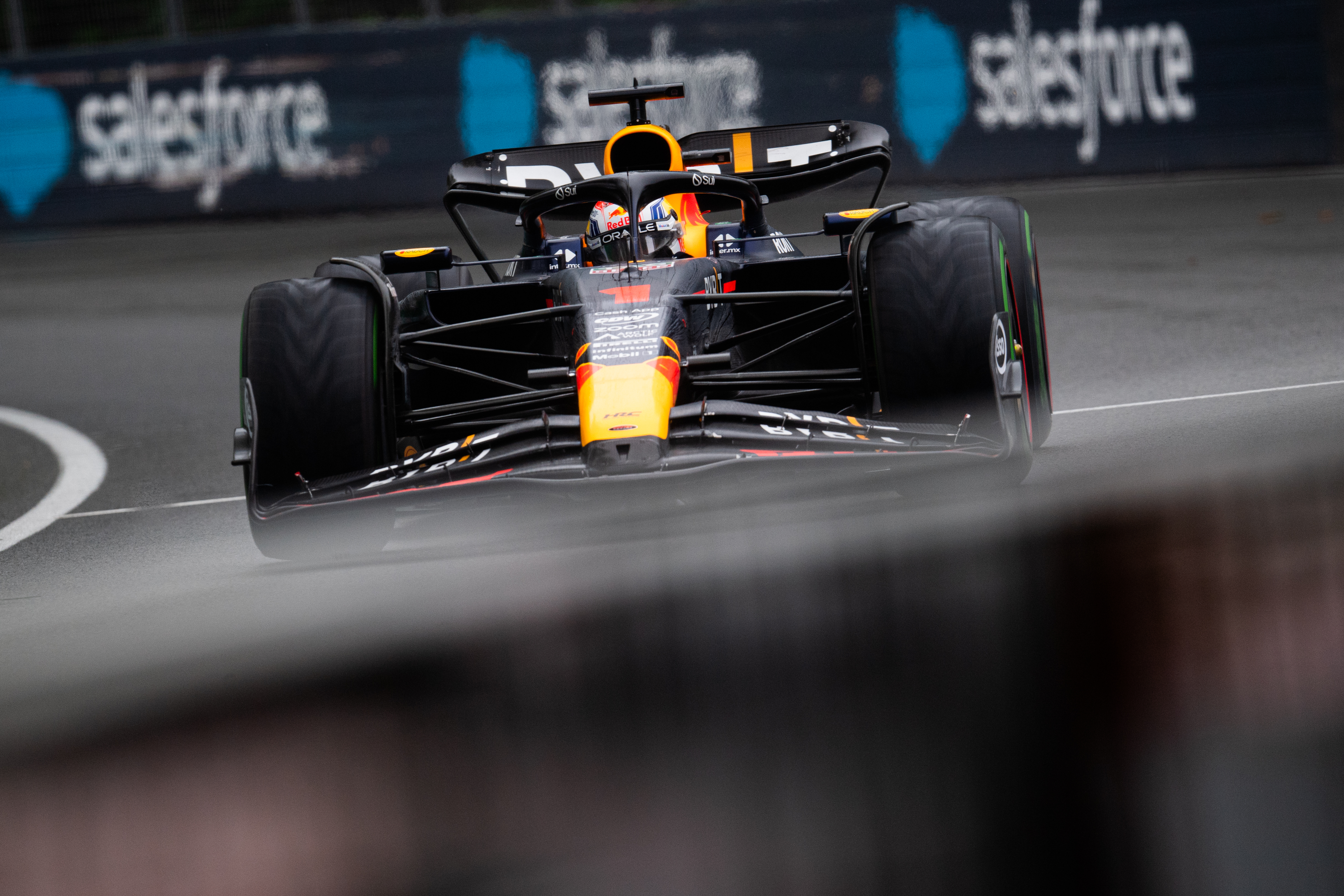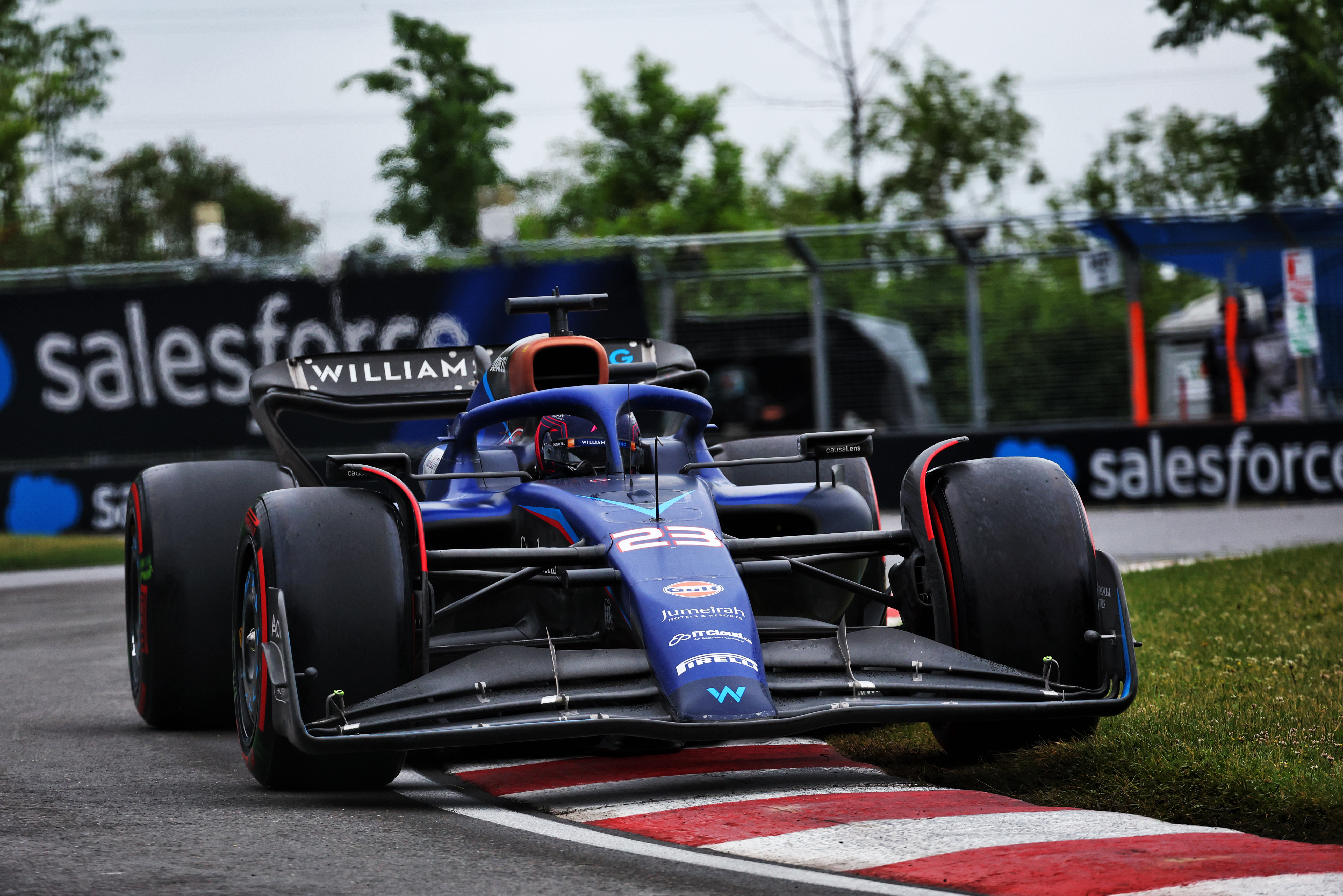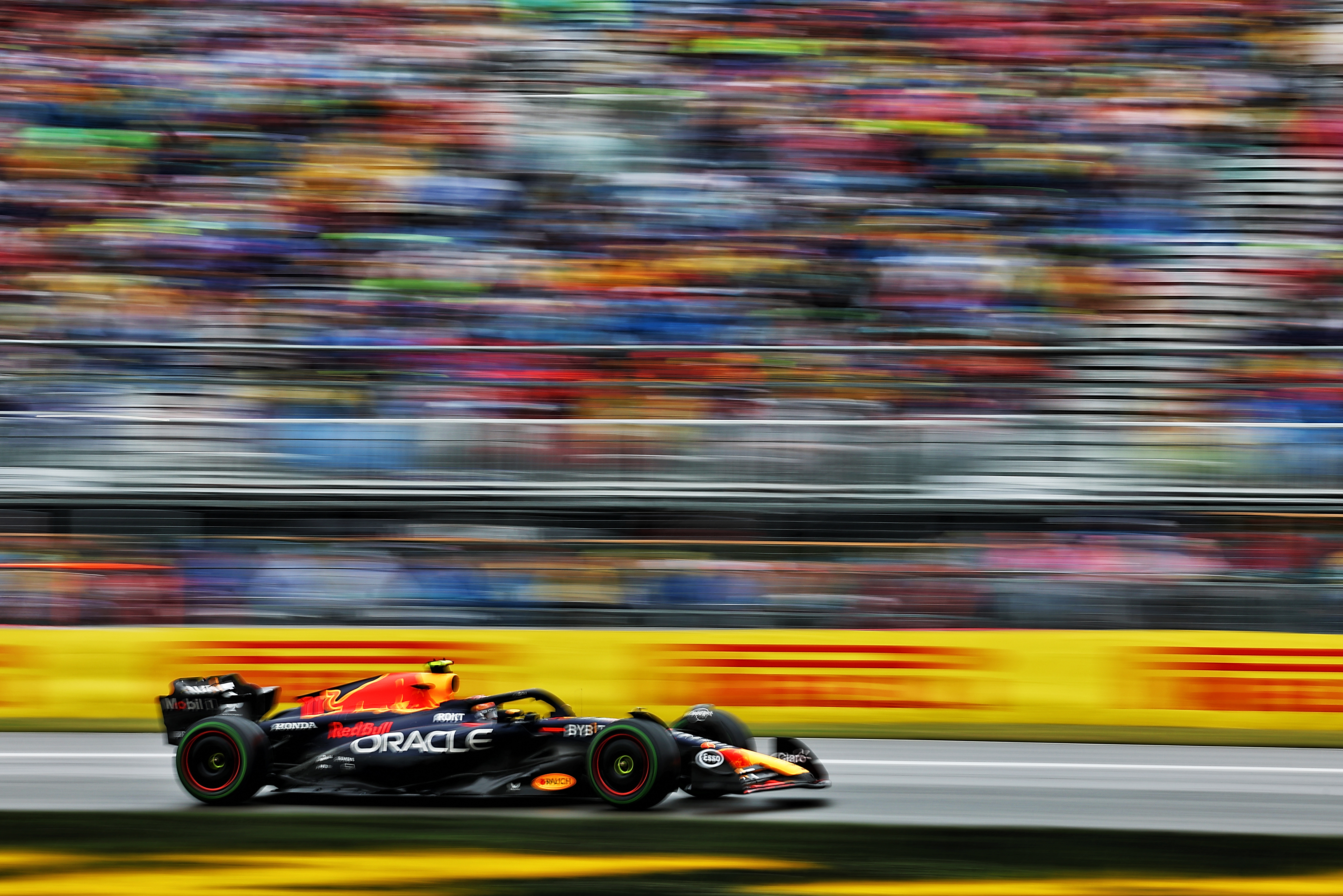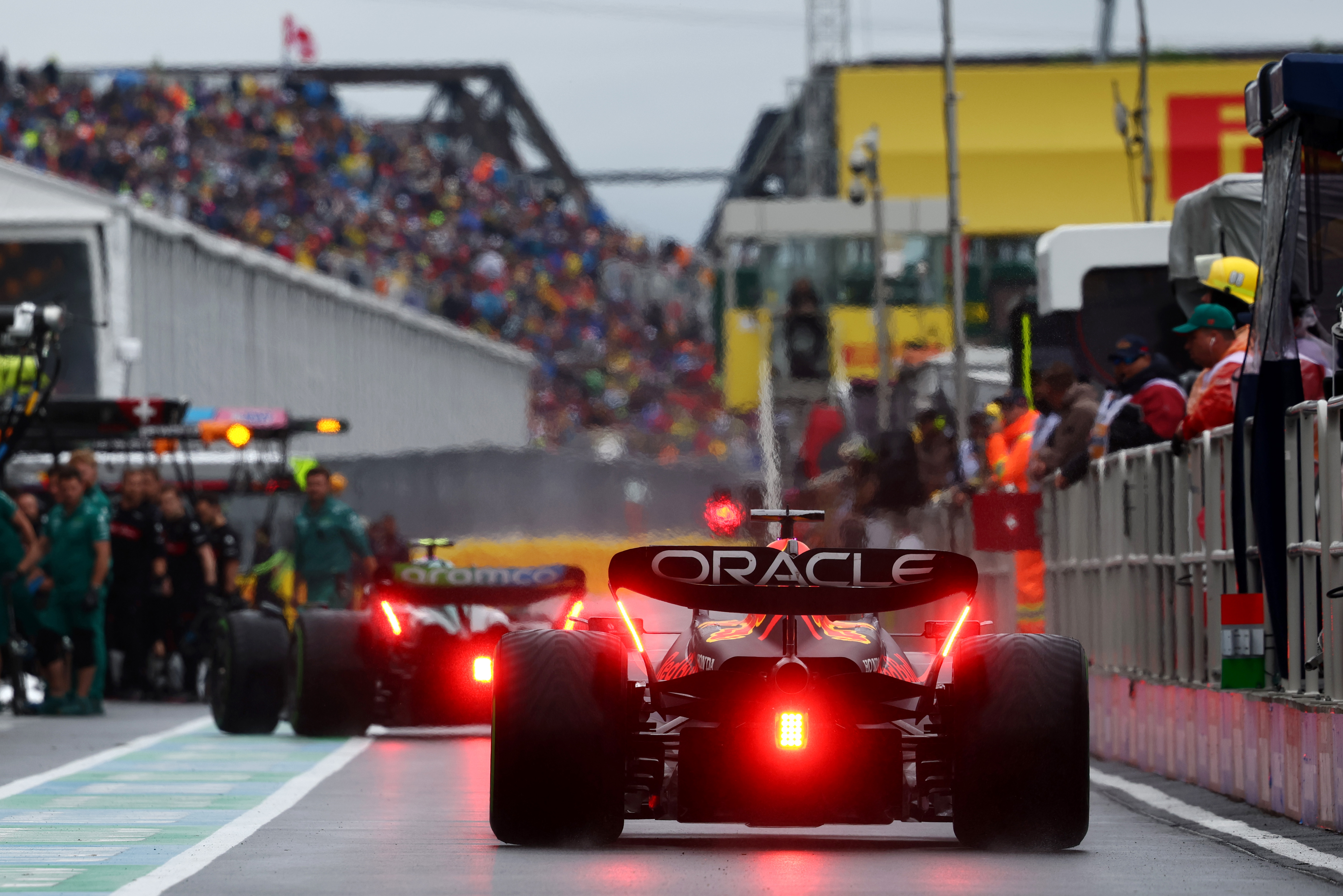Up Next

The crazy environment created by a wet Montreal qualifying, circumstances constantly changing as the knock-out clock counts down, jeopardy at all turns, walls lying in wait beyond glistening wet track, track sometimes drying but big black clouds moving towards you, leaving you not knowing if this is the driest the track will ever be or an irrelevance.
In such situations, cool judgement calls, clear communication, a calm pit wall – and some luck – matter just as much as how quick your car is. Maybe even more, given that we have a Haas qualifying second (pre-penalty) and a Red Bull, Ferrari and Aston Martin failing to make it out of Q2.
Getting each of those right was just the platform for a Max Verstappen pole 1.3s clear of the field. He built upon that platform with routine brilliance, the RB19 dancing and twitching between the walls on his own personal groove, confident enough in the car’s downforce to take lots of apex kerb everywhere, shallow power sliding the outer rear tyre to complete the rotation he needed to stay out the walls on the exits.
Grip changing by the lap, they’ve all been in these situations before, but Verstappen was in particularly comfortable territory in such uncomfortable-looking conditions.
Confidence

“It helps if you’re confident in wet,” he says. “There’s a lot of feeling, what lines to take; it’s difficult to explain why that happens. I remember when my dad was actually standing on track pointing, telling me where to drive in the wet, as I think he was pretty good in the wet in his time.”
He’s talking of karting days, thrashing around soaking wet tracks even after everyone else has taken shelter. Hours of this, not merely circulating, but pushing, learning, listening. Father Jos often tells the story of how even when Max was complaining his hands were going numb with the cold, he’d tell him to sit in the van to warm them up for a few minutes. Then it would be back down to business. Such things form character but also play their part in feeling comfortable and confident when the conditions arise. It all spirals upwards.
Skill

But for it to matter, the skills have to be there and the correct calls have to be made. Q1 was relatively straightforward, fuel up for the full session, inters all the way, just multiple laps taking advantage of the gradually drying track. Fastest by 0.6s from Fernando Alonso’s Aston Martin and the two Mercedes.
Q2 was tricker – beginning on the cusp of inters and slicks, then a small but definite window of slicks, before the rain took the track into inters territory once more. If you were adventurous, maybe looking to risk yourself beyond your natural place – like Alex Albon at Williams, say – you might get straight out there on slicks, be very careful on your first lap, bang in a great lap then hope it was raining again by the time the others had stopped to change their original inters for slicks.
It worked brilliantly for Albon – he went fastest – but in a Red Bull Verstappen had no need to take the initial risk. Especially as the team had got him to the end of the pit lane ahead of everyone else, giving him that extra margin of available time. He delivered the banker lap on inters – which in hindsight would have got him through even if he’d not then pitted for the softs and delivered a lap second only to that of Albon set on a drier track. For the rain was already increasing.
Contrast to team-mate Sergio Perez. Checo’s initial inters lap, 0.7s slower than Verstappen’s equivalent, just wasn’t quite quick enough and everything hinged on his slick-tyred follow-up. Once you’d done the inters lap, there was only the briefest window of slick running. He was in that window, but just didn’t fire up the tyres fast enough. Running straight on at the final chicane ensured he’d need another lap – but by now it was raining again.
In he came to go back onto inters, but it was too late, the track was by now too wet for a top-10 time. Partly circumstantial (he’d have surely got through if the rain hadn’t increased) but indisputably also partly the skill difference. Red Bull should not have needed an adventurous Albon-like strategy to take Perez into Q3, but in hindsight it did.
Taking the initiative

In a very similar situation was Charles Leclerc. Getting out three cars later than Perez, his inters lap was on a wetter track but he went a couple of tenths faster. Not enough, as it turned out, and had the team not insisted he complete the inters lap instead of doing as he was asking and pitting immediately for slicks, he’d almost certainly have made it through. That’s hindsight, of course. And not doing the inters banker could have turned out to be disastrous if the rain had suddenly increased as he was in the pits.
But the banker wasn’t good enough and neither, in the end, was his slick lap. He ran straight on across the final chicane, destroying what would have been a comfortable graduating lap. The rain had arrived now.
A few years ago Robert Kubica had been in a very similar situation, but Robert is a rather more obstinate, decisive character than Leclerc. Stay out he was told by his BMW engineer. Ignoring the call for a vital couple of seconds, he then radioed, “I’m in the pitlane now,” so taking the decision out of their hands…
Luck

Lewis Hamilton had got himself into the same situation as Perez and Leclerc. The only difference was his inters lap was good enough to make Q3 – though only just. He ran wide on his first lap and did another. Meaning he missed the slicks window. That could so easily have put him out.
The interesting comparison to Leclerc and Hamilton here is Lando Norris, third-quickest in Q2, with a great slicks-shod lap. Like Leclerc, he was favouring the idea of slicks as soon as he got out on track. But, just as with Leclerc, his team advised him to stay out and do an inters-shod banker. He began the lap but almost immediately ran very wide at Turns 1-2, ruining it before it had begun. This turned out to be a blessing in disguise, triggering the decision to forget about a banker lap and get straight onto slicks. Abandoning the inters after his error (unlike Hamilton), there’d be no time lost doing a flying lap and in-lap before he could get onto slicks. The time saved allowed him three slick-shod laps.
Keeping it simple

As all these dramas unfolded, Nico Hulkenberg – a long-renowned wet weather specialist – sailed serenely through for Haas. “We just stayed on top of the situation,” he said. “Some of it’s you, some the team, good communication, clean laps, sweet… There are walls and you’re pushing so you never really know what can happen. But we switched the tyres on well. It worked out.”
He made it sound simple but there are so many case studies here of it being anything but. His last slick-shod Q2 lap was completed with the rain increasing but there are few safer pairs of hands on such a situation.
Queuing

Red Bull and Haas bolstered the great efforts of their respective drivers by claiming their positions at the front of the Q3 pitlane queue (Verstappen headed it, Hulkenberg was third, with Esteban Ocon in between).
“The radar was saying it would continue to rain,” Verstappen said. “So it was going to be important to be out there quickly. So we sat at the end of the pitlane, with the tyres going cold but getting clean air and good vision on your lap. We wanted to be at the front.” With his clean air and good vision, he reeled off two laps which would have been good for pole.
The second of Hulkenberg’s two laps secured him second, 1.3s off Verstappen, but this would have been good only for third had the red flag for Oscar Piastri’s accident at Turn 6-7 arrived 4s later. Because that’s how far away from the line Fernando Alonso’s Aston was as he was about to set a time which would have slotted him between Verstappen and Hulkenberg. As it was, his first lap puts him in P3.
If only he’d been able to get out there a little earlier. “We are on long side of the pit lane and that makes a difference,” he said. “Cannot complain because sometimes it works in our favour.”
Of course in the end Hulkenberg’s penalty means Alonso gets that P2 slot after all.
Alonso being Alonso he made mention of his front row performance here last year and what it had in common. “Confidence in the car is key,” he said. “I had a lot of confidence this year. Last year as well…”





